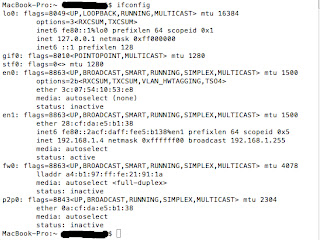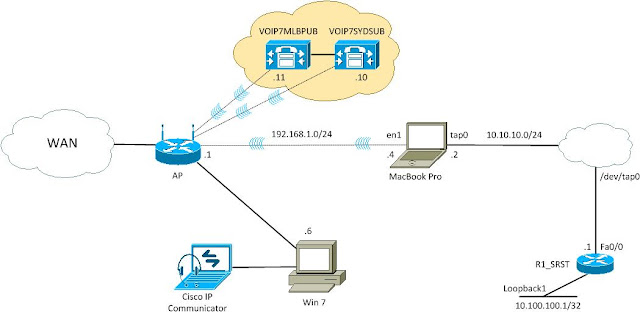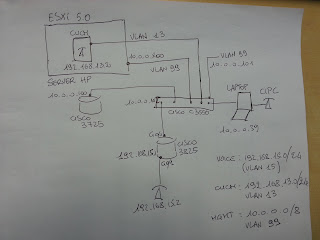Connecting a Router on GNS3 with CUCM 7.0 running on VMware - Mac OS X
The Network topology I set up is the following:
As we can see There are two networks. The first one, 192.168.1.0/24, is the WLAN I have, where I configured a CUCM cluster consisting of a Publisher and a Subscriber running on two different Virtual Machines. On How to install a CUCM 7.0 on VMware please refer to this previous post. I also have an AP and, for future purposes, a SIP Softphone client on my Android smartphone and a Cisco IP Communicator.
Here are the IP Addresses I assigned:
Here are the IP Addresses I assigned:
- VOIP7MLBPUB (Publisher) : .10
- VOIP/SYDSUB (Subscriber) : .11
- Access Point (Ap) : .1
- SIP Client (CSipSimple) : .2
- Cisco IP Communicator : .3
- en1 interface on my MacBook Pro : .4
NOTE : In order to connect this two networks, the CUCM's gateway must be the interface en1 IP address, not the Access Point's.
On GNS3 I configured a 3725 Router R1, running on Cisco IOS Software, 3700 Software (C3725-ADVENTERPRISEK9-M), Version 12.4(18), RELEASE SOFTWARE (fc1).
On GNS3 I configured a 3725 Router R1, running on Cisco IOS Software, 3700 Software (C3725-ADVENTERPRISEK9-M), Version 12.4(18), RELEASE SOFTWARE (fc1).
The simulated network is 10.10.10.0/24.
First of all, I need to provide my MacBook Pro of Tap drivers, I used TunTap for OS X, downloadable here. Once installed we can verify that they are correctly installed by typing on a console
ls /dev
and check if tun and tap virtual interfaces are on the list.
If we now have a look at the interfaces available and in use on the pc, typing
ifconfig
we don't see any tap interface on the list. That is normal because we aren't using it yet.
ls /dev
and check if tun and tap virtual interfaces are on the list.
If we now have a look at the interfaces available and in use on the pc, typing
ifconfig
we don't see any tap interface on the list. That is normal because we aren't using it yet.
Now, on GNS3, we add to our project a cloud object, and configure a tap interface from the NIO TAP configuration window, by typing /dev/tap0 and clicking on Add Button.
If we type ifconfig now, tap0 appears on the list. We need to assign an IP address to this interface, by entering the following command:
sudo ifconfig tap0 10.10.10.2/24
As we can see on the list, tap0 has now an IP address of the simulated network
Now we can configure the FastEthernet0/0 interface on the router in this way:
If we type ifconfig now, tap0 appears on the list. We need to assign an IP address to this interface, by entering the following command:
sudo ifconfig tap0 10.10.10.2/24
As we can see on the list, tap0 has now an IP address of the simulated network
Now we can configure the FastEthernet0/0 interface on the router in this way:
interface FastEthernet0/0
ip address 10.10.10.1 255.255.255.0
duplex auto
speed auto
no shut
It's now possibile to connect the Router to the Cloud and check the connectivity
R1#ping 10.10.10.2
Type escape sequence to abort.
Sending 5, 100-byte ICMP Echos to 10.10.10.2, timeout is 2 seconds:
.!!!!
Success rate is 80 percent (4/5), round-trip min/avg/max = 4/8/12 ms
R1#
MacBook-Pro:~ $ ping 10.10.10.1
PING 10.10.10.1 (10.10.10.1): 56 data bytes
64 bytes from 10.10.10.1: icmp_seq=0 ttl=255 time=18.427 ms
64 bytes from 10.10.10.1: icmp_seq=1 ttl=255 time=4.004 ms
64 bytes from 10.10.10.1: icmp_seq=2 ttl=255 time=1.706 ms
^C
--- 10.10.10.1 ping statistics ---
3 packets transmitted, 3 packets received, 0.0% packet loss
round-trip min/avg/max/stddev = 1.706/8.046/18.427/7.400 ms
MacBook-Pro:~ $
The problem now is that the ip forwarding is not enable, thus R1 can not ping the en1 interface on the laptop, that is part of 192.168.1.0 network, where CUCM resides.
R1#ping 192.168.1.4
Type escape sequence to abort.
Sending 5, 100-byte ICMP Echos to 192.168.1.5, timeout is 2 seconds:
.....
Success rate is 0 percent (0/5)
To do that, at first we need to set up the ip forwarding on the laptop, if it has not done before
sudo sysctl -w net.inet.ip.forwarding=1
After that we need to add a static route in our gateway configuration in order to use the tap0 interface to go outside the 10.10.10.0 network
R1(config)#ip route 0.0.0.0 0.0.0.0 10.10.10.2
now, as we can see...
R1(config)#ip route 0.0.0.0 0.0.0.0 10.10.10.2
now, as we can see...
R1#ping 192.168.1.4
Type escape sequence to abort.
Sending 5, 100-byte ICMP Echos to 192.168.1.4, timeout is 2 seconds:
!!!!!
Success rate is 100 percent (5/5), round-trip min/avg/max = 8/12/20 ms
CUCM is now reachable from R1.





Aniecredmys-zaOmaha Delreece Pentapati Download crack
ReplyDeletekkeepeasdeehigh